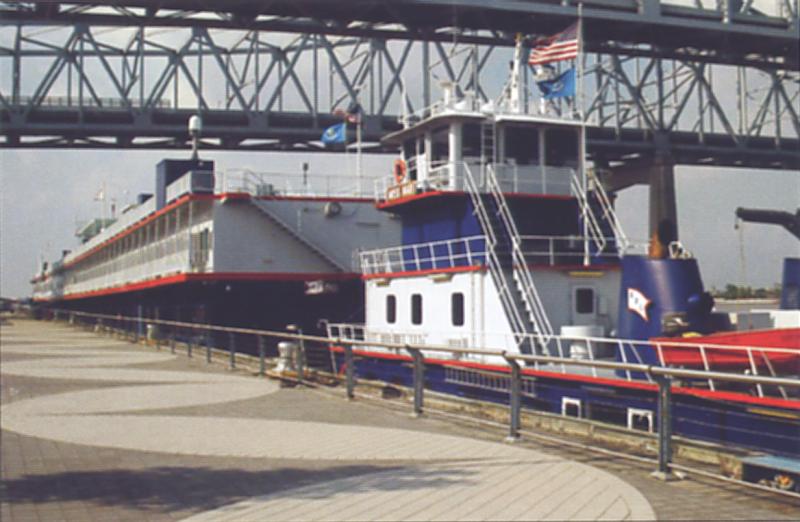
The Waterways Journal
18 June 2007
By Capt. Richard Eberhardt
To get any closer to the action on the Mississippi River system, you'd have to carry rachet sets, or someone would hand you a chipping hammer and paint brush.

The River Explorer docked in New Orleans.— WJ Photo by Capt. Richard Eberhardt
RiverBarge Excursion Lines operates a unique tow, powered by the 3,000 hp Miss Nari. Two barges—the LaSalle is the after one with sleeping suites and the DeSoto is the forward one having facilities for viewing — galley and entertainment, carry the guests.
Out front is a bowthruster unit for steering. The Miss Nari has 360-degree Z-drives, making it a very maneuverable tow. With three decks, including the 25,000-square-foot open-air Sky Deck, the overall dimension is 778 by 54 feet on the River Explorer, as the total unit is called.
Many passengers enjoy the ride in the guest pilothouse, situated on the forward end of DeSoto barge, with an unobstructed view forward from two rows of comfortable theater seats. There they can truly get a feel of the waterways as VHF radios allow passengers to listen in on bridge-to-bridge conversations.
Large displays show the GPS position and radar monitors.
After cruising for nine years, wheelmen on workboats along the river know the River Explorer and pass by to get a look at the many passengers.
Indeed, while sitting at the dock at the Port of New Orleans, two light pushboats passed close by, one within 70 feet. Looking in the open galley door on one passing pushboat, one could see the television playing above the settee.
It seems the only thing missing is the ever-present chatter of the generator and rumble of the main engines that workboat crews have come to expect. Crew quarters are located nearest the GM 12-149 generators, insulating the passenger cabins.
"Passengers actually have to look out the windows to see if we're moving," explained Jeff Kindl, the chief operations officer of River Barge Excursion Lines. The rolling and pitching experienced by passengers on ocean liners, and the sea-sickness, are never felt on the rivers.
On one recent cruise along the Gulf Intracoastal Waterway (GIWW) to Corpus Christi in southern Texas, passengers saw 70 whooping cranes, some right on the canal bank, Kindl explained. In the 1960s, there were only about 30 whooping cranes worldwide, but conservation efforts now have the population of the magnificent birds at an estimated 300.
Local culture is featured at each stop. In Natchez, it's a tour of the Antebellum homes that were spared from destruction during the Civil War; in Vicksburg, passengers tour the Civil War battleground, site of one of the longest sieges in U.S. history and now a National Park; in Helena, Ark., visitors watch a live performance of the King Biscuit radio program. Each boarding/destination city offers a unique experience.
For the summer, the River Explorer is leaving the Lower Mississippi River for cruises on the Upper Mississippi, Ohio and Illinois rivers. Along the way, stops are scheduled for passengers to disembark for tours to get a flavor of the great river towns: St. Louis, Nashville, Cincinnati, Memphis, Louisville, even Pittsburgh.
Other boarding/destination cities are well known to river crews: Paducah, Cape Girardeau, Ripley, Pt. Pleasant and more.
All tours of the river towns are included in the price of admission. While that price is higher than an ocean cruise at first glance, all tours and tips, which can run into the hundreds of dollars, are included. All meals are included. Passengers only pay extra for alcoholic beverages and gift shop purchases.
With a traditional barge beam of 54 feet, a passenger sitting in the Galley dining room can view the passing scenery on both banks of the waterway through expansive windows while dining on a main course that is reflective of the area.
In the upper deck staterooms, a passenger can step out to the semi-private balcony to feel the river and hear the sounds, since the staterooms are so well sound-insulated.
On the lower deck, the passenger is only a few feet away from the water and there is no balcony onto the working deck. Three staterooms on the bottom deck accommodate passengers in wheelchairs.
All staterooms feature a wall of glass where passengers can lounge and still view the passing scenery. And unlike some cruise ships, all the rooms and baths seem amazingly spacious.
A large two-story Sprague Theater, named after the largest riverboat to ply the Mississippi River, offers entertainment. Some performing artists travel aboard, but as often as not, they board the River Explorer to perform in the Sprague Theater.
While the majority of the passengers are 60-plus in age, Kindl said he has watched the younger ones who seem to really enjoy the views and river traffic.
Forty percent of passengers are repeat guests and have sailed on the River Explorer before their current trip. Many want to experience a different segment of the fascinating inland waterways.
Depending on the number of passengers, there can be from 35 to 50 crew members. Kindl said some have been with the company since its beginning, but others work for the experience and move on.
Mariners working on the inland rivers often bring home stories of their adventures to their families. The River Explorer offers passengers the opportunity to share those experiences in pampered luxury. And no one has to pick up a paint brush.